
Orchids are plants that belong to the family Orchidaceae, a diverse and widespread group of flowering plants with blooms that are often colourful and fragrant. Orchids are cosmopolitan plants that are found in almost every habitat on Earth except glaciers. The world's richest diversity of orchid genera and species is found in the tropics.

Joseph Marie Henry Alfred Perrier de la Bâthie was a French botanist who specialized in the plants of Madagascar.

Cypripedium acaule, the pink lady's slipper or moccasin flower, is a species of flowering plant in the orchid family Orchidaceae native to eastern North America. It is currently the provincial flower of Prince Edward Island, Canada, and the state wildflower of New Hampshire, United States.

Cryptopus, abbreviated Crypt. in the horticultural trade, is an orchid genus with 4 species native to Madagascar, Mauritius and La Réunion.

Jumellea is an orchid genus with 55 species native to Madagascar, the Comoros, the Mascarenes, and eastern Africa. In horticulture, it is often abbreviated Jum.

Goodyera oblongifolia is a species of orchid known by the common names western rattlesnake plantain and giant rattlesnake plantain. It is native to much of North America, particularly in the mountains of the western United States and Canada, from Alaska to northern Mexico, as well as in the Great Lakes region, Maine, Quebec and the Canadian Maritime Provinces.
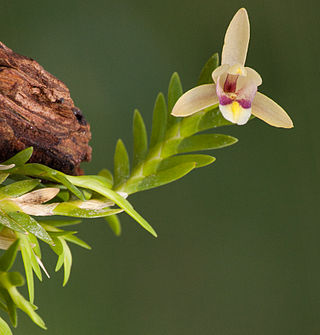
The Vandeae is a large monophyletic tribe within the family of orchids.

Beclardia is a genus of flowering plants from the orchid family, Orchidaceae. There are two recognized species, both native to islands in the Indian Ocean:
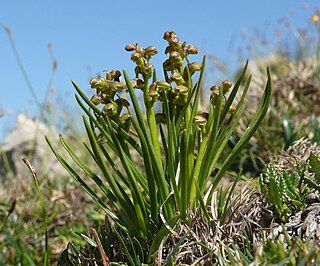
Chamorchis is a genus of flowering plants from the orchid family, Orchidaceae. It contains only one known species, Chamorchis alpina, known as the alpine dwarf orchid, false orchid or false musk orchid, and found in subarctic and subalpine parts of Europe: Scandinavia, the Alps, the Carpathians, northern European Russia.
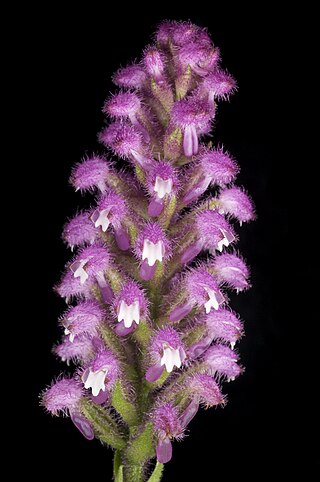
Cynorkis is a genus of orchids in the subtribe Orchidinae. Species in this genus are native to mainland Africa, the Comoro Islands, the Mascarene Islands, and Madagascar.

Grammangis is a genus of flowering plants from the orchid family, Orchidaceae. It contains only two known species, both endemic to Madagascar.
Tylostigma is a genus of flowering plants from the orchid family, Orchidaceae, endemic to Madagascar.
Hederorkis is a genus of flowering plants from the orchid family, Orchidaceae. It contains two known species, both native to islands in the Indian Ocean.

Megalorchis is a genus of flowering plants from the orchid family, Orchidaceae.
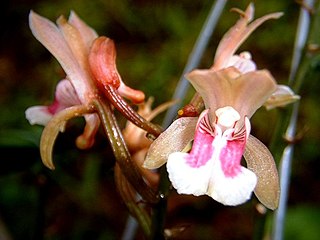
Oeceoclades, collectively known as the monk orchids, is a genus of flowering plants from the orchid family, Orchidaceae. It is related to Eulophia and like that genus is mostly terrestrial in habit. A few species extend into very arid environments, unusual for an orchid.
Platylepis is a genus of flowering plants from the orchid family, Orchidaceae. It is widespread across sub-Saharan Africa and also on various islands of the Pacific and Indian Oceans.
- Platylepis bigibbosaH.Perrier - Madagascar
- Platylepis bombusJ.J.Sm. - Seram
- Platylepis commelynae(Lindl.) Rchb.f. - Society Islands
- Platylepis constricta(J.J.Sm.) J.J.Sm. - New Guinea
- Platylepis densifloraRolfe - Réunion
- Platylepis geluana(Schltr.) Schuit. & de Vogel - New Guinea
- Platylepis glandulosa(Lindl.) Rchb.f. - widespread across tropical and southern Africa
- Platylepis grandiflora(Schltr.) Ormerod - New Caledonia, Vanuatu, Futuna
- Platylepis heteromorphaRchb.f. - Samoa
- Platylepis intricataSchuit. & de Vogel - Papua New Guinea
- Platylepis lamellataSchltr. - New Guinea
- Platylepis margaritiferaSchltr. - Madagascar
- Platylepis occulta(Thouars) Rchb.f. - Madagascar, Réunion, Mauritius, Seychelles
- Platylepis polyadeniaRchb.f. - Madagascar, Comoros
- Platylepis rufa(Frapp.) Schltr. - Réunion
- Platylepis tidorensisJ.J.Sm. - Maluku
- Platylepis viscosa(Rchb.f.) Schltr. - Réunion
- Platylepis xerosteleOrmerod - Cameroon
- Platylepis zeuxinoidesSchltr. - New Guinea
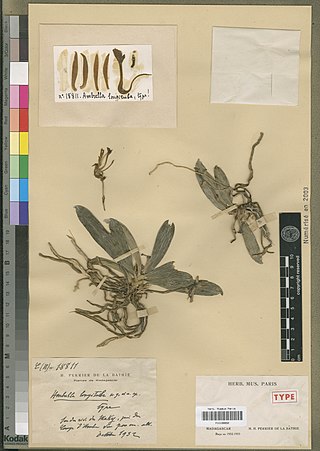
Ambrella is a monotypic genus in the orchid family. The single species, Ambrella longituba is endemic to Madagascar. The type specimen was collected and described by Joseph Marie Henry Alfred Perrier de la Bâthie in 1934.

Liparis liliifolia, known as the brown widelip orchid, lily-leaved twayblade, large twayblade, and mauve sleekwort, is a species of orchid native to eastern Canada and the eastern United States. It can be found in a variety of habitats, such as forests, shrublands, thickets, woodlands, and mountains. The orchid is considered globally secure, but it is considered rare or endangered in many northeastern states.
Oeceoclades humbertii is a terrestrial orchid species in the genus Oeceoclades that is endemic to southeastern Madagascar, where it grows in xerophilous bush at altitudes from 500 to 600 m. It was first described by the French botanist Joseph Marie Henry Alfred Perrier de la Bâthie in 1939 as Lissochilus humbertii and moved to the genus Eulophia in 1975 by Friedhelm Reinhold Butzin. It was last transferred to the genus Oeceoclades in 2001 by Jean Marie Bosser and Philippe Morat. The type specimen was collected from the left bank of the Manambolo valley in the Mandrare River basin in either December 1933 or January 1934 when it was recorded as flowering by its collector Jean-Henri Humbert for whom the specific epithet humbertii honors. The small pseudobulbs are conical and heteroblastic. Oeceoclades humbertii is distinguished from all other Oeceoclades by its completely green flowers. It has only been collected twice including the type specimen; the other specimen was collected by Philippe Morat in 1973 from the Onilahy valley in the Ankazoabo gorges north of Betioky.














